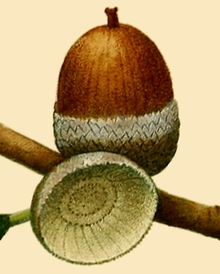en
names in breadcrumbs


The debate over whether Quercus prinoides is distinct from Q . muhlenbergii has continued for most of the last century. Little doubt can exist that strong genetic differences, as expressed by characteristics of habit, leaf form, and habitat preference, separate the two taxa; the question is merely whether they are best treated as subspecies or varieties or as separate species. Over most of the eastern United States, the two taxa occur sympatrically over broad areas with little immediate contact (syntopy), because Q . muhlenbergii is found on calcareous soils and Q . prinoides occurs on sands (often acidic) and dry shales. Seedlings of Q . prinoides can flower and produce acorns in as few as 3-5 years from planting, when only 20-50 cm, and maintain their dwarf, clonal habit in cultivation. Quercus muhlenbergii begins fruiting as a small tree of 3 m or more in height. Because of these differences, and interdigitating geographic distributions, the two taxa seem to be similar in pattern of variation and interaction to other closely related oak species of eastern North America, and dissimilar in pattern to infraspecific taxa such as we see in Q . sinuata var. sinuata and Q . sinuata var. breviloba . The populations that are difficult to determine are usually small scrubby trees, probably mostly Q . muhlenbergii , stunted because of less than favorable moisture conditions, with or without indications of introgression from Q . prinoides .
Material of Quercus prinoides from Long Island, coastal Massachusetts, Nantucket Island, and Martha's Vineyard has been segregated as Q . prinoides Willdenow var. rufescens Rehder on the basis of vestiture and minor differences in leaf form. These populations have appressed-stellate leaf pubescence abaxially, as throughout the range of the species; in addition they have reddish, erect, fasiculate hairs similar to those found in Q . michauxii . The hairs make the abaxial leaf surface somewhat felty to the touch. Variability in this characteristic and lack of other consistently correlated features preclude taxonomic recognition of Q . prinoides var. rufescens , but this problem is worthy of further investigation.
Quercus prinoides, commonly known as dwarf chinkapin oak, dwarf chinquapin oak, dwarf chestnut oak or scrub chestnut oak, is a shrubby, clone-forming oak native to central-eastern North America.
The dwarf chinkapin oak is a shrub or small tree that typically grows up to 13–20 feet (4–6 meters) tall and 13–20 ft (4–6 m) wide. It sometimes spreads vegetatively by means of underground rhizomes.[3] The leaves of dwarf chinkapin oak closely resemble those of chinkapin oak, but are smaller: 5–15 centimeters (2–6 inches) long, compared to 10–18 cm (4–7 in) long for chinkapin oak. The acorns are 15–25 millimeters (1⁄2–1 in) long, with the cup enclosing about half of the acorn.[4]
While similar in foliage and fruits, but with smaller leaves, the dwarf chinkapin oak may also be distinguished from the chinkapin oak by differences in growth habit (the clonally spreading shrubby growth form and smaller proportions of dwarf chinkapin oak, even when grown on rich soils) and habitat (the chinkapin oak is typically found on rocky, calcareous sites, while the dwarf chinkapin oak is more typically found on dry, often acidic, sandy soils or dry shales).[4]
Like all white oaks, Q. prinoides has sweet-tasting green acorns that mature in a single growing season and germinate as soon as they fall to the ground with no winter dormancy. It freely hybridizes with any other species in the white oak group. Flowering and seed production begin at 3–4 years old.
Quercus prinoides was named and described by the German botanist Karl (Carl) Ludwig Willdenow in 1801,[4] in a German journal article by the German-American Pennsylvania botanist Gotthilf Heinrich Ernst Muhlenberg.[5] The epithet prinoides refers to its resemblance to Quercus prinus, the chestnut oak.
However, this shrubby oak, now generally accepted as a distinct species, is more closely related to chinkapin oak (Q. muhlenbergii) than to chestnut oak.[4] These two kinds of oak have sometimes been considered to be conspecific (belonging to the same species), in which case the earlier-published name Q. prinoides has priority, with the larger chinkapin oak then usually classified as Quercus prinoides var. acuminata, and the shrubby form as Q. prinoides var. prinoides. It is roughly analogous to the bear oak, which forms part of the red oak group, but has a much wider distribution than bear oak, which occurs in a relatively small area of the northeastern US.
The species range extends from eastern Nebraska, south to Oklahoma (with an isolated population in Louisiana), east to northern Alabama and Georgia, northeast to New Hampshire, and in southeast Canada, extending as far north as the Carolinian forest zone of southern Ontario. It has a virtually disjunct (discontinuous) distribution, fairly common in New England and in the Appalachian Mountains, and also in the eastern Great Plains but rare in the Ohio Valley in between.[6]

The acorns of dwarf chinkapin oak are sweet tasting and relished by humans and many kinds of wildlife. The wood has little commercial value because of the shrub's small size.
Quercus prinoides, commonly known as dwarf chinkapin oak, dwarf chinquapin oak, dwarf chestnut oak or scrub chestnut oak, is a shrubby, clone-forming oak native to central-eastern North America.